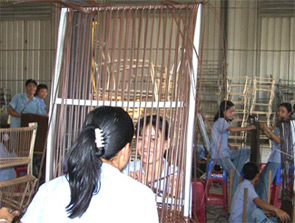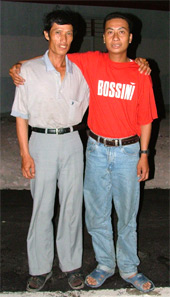|
|
Several years ago my wife and I returned to our first church plant for a Christmas worship service. Some years had passed since we worshipped with the believers and many changes had taken place. The church had a full-time pastor. New families were a part of the church with some now serving in key leadership roles. As we worshipped together, we sang songs to celebrate the birth of Christ. The pastor preached on a familiar Christmas passage from the Gospel of Luke. We then collected the offering. As the offering was collected, the pastor left the worship hall and departed through the back door. The ushers collected the offering and then the children and youth presented a brief drama on the historic event of Christ’s birth.
My wife and I delighted in how the church had grown numerically and how the believers had grown to become leaders in the church. Then something happened. The pastor came back into the sanctuary dressed like Santa Claus. As he paraded around distributing gifts, the pianist began playing a familiar tune and the church members began singing “Ding Dong Hong, Ding Dong Hong.” In English, that song is “Jingle Bells.”
My wife and I looked at one another in astonishment. What happened? We did not teach them to celebrate Christmas with Santa Claus nor did we teach them to sing “Jingle Bells.” I wondered, where did the people learn these expressions of Christmas? When asked, they said they learned to celebrate Christmas with Santa Claus and “Jungle Bells” by watching movies from the United States.
Cultural Appropriation
In the above situation and in many countries, new Christian believers sometimes borrow what they see others outside their culture do to celebrate events such as Christmas and Easter. In some situations, this borrowing often comes from the West and more specifically from American culture.
This process of borrowing from one culture another is labeled cultural appropriation. Cultural appropriation is “the taking—from a culture that is not one’s own—of intellectual property, cultural expressions or artifacts, history and ways of knowledge.”1 No matter the context, people constantly experience changes through innovations (internal) and diffusion (external). Through the process of diffusion, they borrow things, ideas and behavior patterns from others. The amount of cultural diffusion varies from place to place with the amount of contact among cultures. That is, the more contact among cultures, the more likely that things, ideas and behavior patterns will be diffused and borrowed. Anthropologist John Yellen has shown how a total culture (the Kalahari !Kung) can change when exposed to foreign goods and ideas.2
Critical Incarnational Living
Borrowing is inevitable. It is going to happen as people are exposed to new cultural forms, ideas and behavior patterns from others. With this in mind, cross-cultural workers should realize that people are watching us. They observe what clothes we wear, the food we eat and the conversations we have with others. They observe and learn what we value most (our own cultural values) and see those things that drive our everyday activity and behavior. They see how we strive to initiate change. They also watch what cultural forms we use to worship. In so doing, the people might mistakenly borrow some of our Western traditions and ways of celebrating Christ events, believing that those very traditions and ways express the true meaning of the Christian faith. In other words, we might unintentionally be the very reason why something less than the true Christian faith is planted.
![]()
|
|
Therefore, we need honesty in our task. We need introspection, learning to compare and contrast our own cultural baggage with the essence of what is Christian. Learning to compare and contrast happens best by living in a cross-cultural setting. This is the beginning of contextualization; that is, critical incarnational living.
Paul Hiebert’s classic article entitled “Critical Contextualization”3 offers much help for missionaries. His critical contextualization model involves three steps. Step one is to “study the local culture phenomenologically.” He insists that “here the local church leaders and the missionary lead the congregation in uncritically gathering and analyzing the traditional beliefs, and customs associated with some question at hand.” Step two requires exegesis of the scripture. In this second step, “the pastor or missionary leads the church in a study of the scriptures related to the question at hand” (1987:109). Step three involves a critical response, requiring “the people corporately to evaluate critically their own past customs in the light of their new biblical understandings.”
It appears that Hiebert’s model presupposes two things: (1) the existence of a church among the people or a particular culture and (2) that missionaries are living among and already actually in a position of knowing the culture at hand to assist others in the critiquing process. With that in mind, Hiebert’s model raises several questions.
- What if there is no church among the people or culture?
- What if cross-cultural workers are planting a church in an area or among a people that have a distinct culture separate from any existing church?
- What if there are many co-cultures side by side?
- Do cross-cultural workers first call in the existing church to minister to the people?
This might be one approach. However, this article proposes another approach.
It proposes that the first step is not critical contextualization with a local body of believers. Nor is it to work alongside a group of Christian believers who have close cultural affinity with the focus people. Instead, it proposes critical incarnational living.
Critical incarnational living teaches cross-cultural workers the deeper meaning of cultural forms. It teaches cross-cultural workers how to act and behave. More importantly, it tells cross-cultural workers how people interact, what they value and treasure in life. Hence, critical incarnational living and contextualization of the gospel go hand in hand. George Hunter words it this way,
“The gospel’s ambassador is called to adapt to the cultural forms of the target population. All of ‘us’ have received the gospel ‘wrapped’ in the clothing of our particular culture….But when we too closely identify the gospel treasure with earthen vessels in which we received it, its communication to people of other cultures or subcultures is frustrated. Our task is to ‘rewrap’ the gospel in the clothing of their culture, to convey it in a vessel that will transport the gospel meaning to them.”4
Without critical incarnational living, cross-cultural workers can easily fail at contextualizing the gospel. It would be a tragedy if cross-cultural workers traveled twelve thousand miles and failed to walk the last twelve inches—not knowing the cultural context and not striving to become an in-group member of the people. Consequently, critical incarnational living becomes the first task for contextualization. In so doing, cross-cultural workers are in a better position to help the people understand what is worth borrowing and what is not.
Endnotes
1. Ziff, Bruce and Pratima V. Rao. 1997. Borrowed Power: Essays on Cultural Appropriation. New Brunswick, New Jersey, USA: Rutgers University Press.
2. Yellen, John E. 1990. “The Transformation of the Kalahari !Kung.” Scientific American. 262 (4):96.
3. Hiebert, Paul G. 1987. “Critical Contextualization.” International Bulletin of Missionary Research. 2 (3):104-11.
4. Hunter, George G. 1987. To Spread the Power. Nashville, Tennessee, USA: Abingdon Press.



